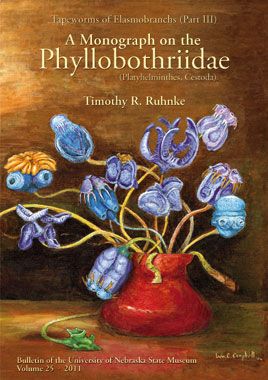
Museum Bulletins
Volume 25
A Monograph on the Phyllobothriiidae
(Platyhelminthes, Cestoda)

Volume: 25
Author(s): T. R. Ruhnke. 2011. 208 pages.
Abstract
This monograph is an attempt to provide information on the taxonomic status of all genera associated with the tetraphyllidean family Phyllobothriidae. Full treatment of the three valid species of the type genus, Phyllobothrium, in addition to the 47 valid species of Clistobothrium, Crossobothrium, Marsupiobothrium, Monorygma, Nandocestus, Orectolobicestus, Orygmatobothrium, Paraorygmatobothrium, Ruhnkecestus, and Scyphophyllidium are provided.
A taxonomic history of the family is provided. Of the genera historically associated with the family, only Phyllobothrium is considered unambiguously valid. The genera Bibursibothrium, Calyptrobothrium, Cardiobothrium, Clistobothrium, Crossobothrium, Doliobothrium, Flexibothrium, Marsupiobothrium, Monorygma, Nandocestus, Orectolobicestus, Orygmatobothrium, Paraorygmatobothrium, Ruhnkecestus, Scyphophyllidium, and Thysanocephalum are considered provisionally valid. The status of the remaining genera was determined.
Aocobothrium, Dittocephalus, Hoaleshwaria, Phanobothrium, and Shindeobothrium are considered nomina dubia. Phyllobothrideum has been determined to be a nomen ad interim. Bilocularia, Biporophyllaeus, Cyatocotyle, Kowsalyabothrium, Maccallumiella, Mastacembellophyllaeus, Pillersium, Pithophorus, and Polipobothrium are considered genera inquirendae. Anindobothrium, Anthobothrium, Carpobothrium, Caulobothrium, Caulopatera, Ceratobothrium, Dinobothirum, Gastrolecithus, Guidus, Mixophyllobothrium, Myzocephalus, Myzophyllobothrium, Pelichnibothrium, Rhoptrobothrium, Trilocularia, and Zyxibothrium are considered incertae sedis. Anthocephalum, Echeneibothrium, Rhabdotobothrium, Rhinebothrium, Rhinebothroides, Rhodobothrium, Scalithrium, and Spongiobothrium are members of the Rhinebothriidea. Clydonobothrium, Escherbothrium, Notomegarhynchus, Pararhinebothroides, Pentaloculum, Phormobothrium, Pseudanthobothrium, and Tritaphros are considered provisional members of the Rhinebothriidea, and Shindeiobothrium is considered genus inquirendum within that order.
Duplicibothrium and Glyphobothrium are members of the Serendipidae, and Myliobatibothrium is considered a genus inquirendum within that family. In addition to the type species, Phyllobothrium lactuca, P. riseri, and P. serratum are considered valid species of Phyllobothrium. Of the remaining species that have been associated with Phyllobothrium, 26 are species that are valid members of other rhinebothriidean or tetraphyllidean genera. Nine species of Phyllobothrium were designated for larval forms. Thirty-five species are considered incertae sedis members of Phyllobothrium or other genera, six are considered species inquirendae within Phyllobothrium or other genera, four species are considered nomina dubia within Phyllobothrium or other genera, and two species of Phyllobothrium are considered to be nomina nuda.
The valid species of Clistobothrium are the type species, C. carcharodoni, in addition to C. montaukensis and C. tumidum. The valid species of Crossobothrium include the type species, C. laciniatum, in addition to C. campanulatum and C. dohrni. Of the six other species associated with Crossobothrium, four are valid members of Paraorygmatobothrium, one is incertae sedis, and one is incertae sedis within Phyllobothrium.
Marsupiobothrium alopias is the sole member of Marsupiobothrium. Of the seven other species names associated with Marsupiobothrium, four species are incertae sedis, one is incertae sedis within Orygmatobothrium, and two are valid species of Guidus.
Valid species of Monorygma include the type species, M. perfectum, in addition to M. macquariae, and M. magnum. Of the eight other species names associated with Monorygma, two were originally designated for larval forms and both are species inquirendae. In addition, one species is a synonym, one is nomen nudum, one is nomen dubium, one is species inquirendum, and two are incertae sedis.
Nandocestus is represented by the monotypic Nandocestus guariticus.
Orectolobicestus is represented by the type speices, O. tyleri, in addition to O. chiloscylii, O. kelleyae, O. lorettae, O. mukahensis, and O. randyi.
Orygmatobothrium is represented by the type species, Orygmatobothrium musteli in addition to O. juani and O. schmitti. Of the 12 other species names associated with Orygmatobothrium, one is a synonym, two are incertae sedis, three are valid species within other genera, one was originally designated for a larval form and is considered a nomen dubium within Anthobothrium, three others are nomina dubia, one is species inquirendum, and one is species inquirendum within Pithophorus.
In addition to the type species Paraorygmatobothrium prionacis, P. angustum, P. arnoldi, P. bai, P. barberi, P. exiguum, P. filiforme, P. floraformis n. comb., P. janineae, P. kirstenae, P. leuci n. comb, P. musteli n. comb., P. nicaraugensis n.comb., P. orectolobi n. comb., P. paulum n. comb., P. roberti, P. rodmani, P. triacis, and P. typicum n. comb. are valid members of the genus. A key to the species of Paraorygmatobothrium is provided.
Ruhnkecestus is represented by the monotypic R. latipi.
The type of Scyphophyllidium is S. giganteum, and S. uruguayense is an additional species. Of the three additional species that have been associated with Scyphophyllidium, one is a valid member of Paraorygmatobothrium, one was designated for a larval form and is incertae sedis, and one is nomen dubium.
Chimaerocestos is currently placed within its own family, the Chimaerocestidae, but should be considered a phyllobothriid whose status is incertae sedis. Phylogenetic information clearly indicates the family to be either paraphyletic or polyphyletic. A number of genera are either members or likely members of the Rhinebothriidea. No evidence exists for the monphyly of the remaining genera from sharks, although putative monophyletic subsets exist within the shark phyllobothriids.





